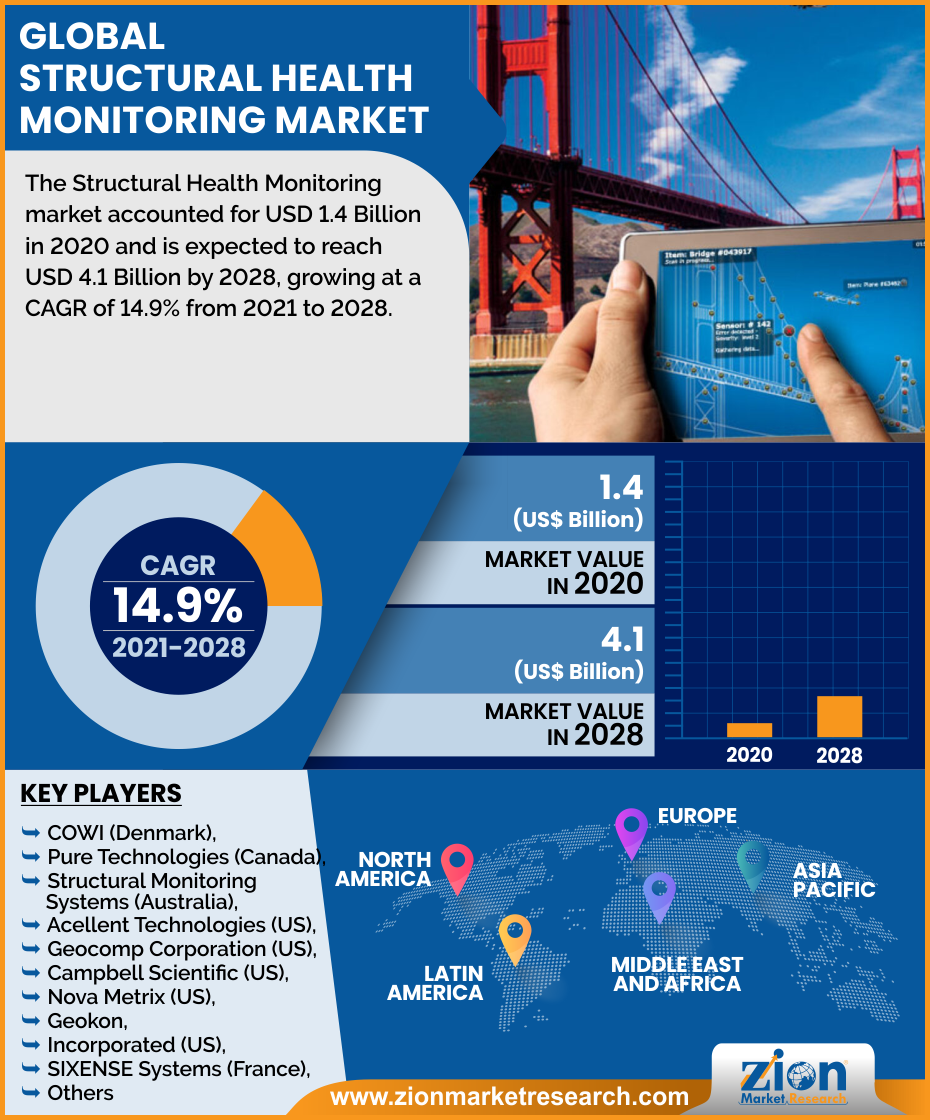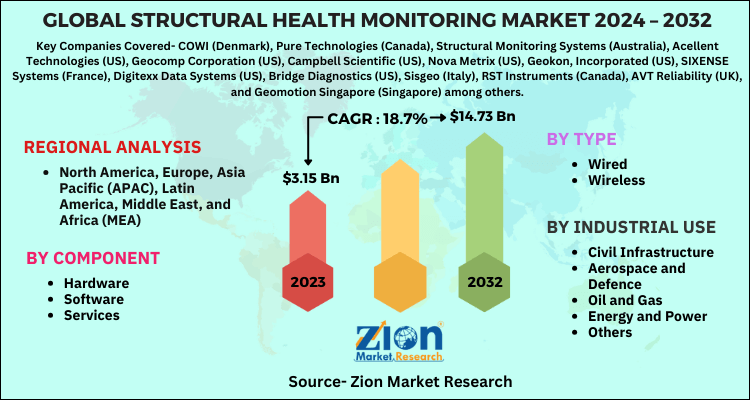Structural Health Monitoring Market Size, Share, Growth, Trends, and Forecast, 2032

Structural Health Monitoring Market by Type (Wired and Wireless), by Component (Hardware, Software and Services), by Industrial Use (Aerospace and Defence, Oil and Gas, Civil Infrastructure, Energy and Power and Others): Global Industry Perspective, Comprehensive Analysis and Forecast, 2024 - 2032
| Market Size in 2023 | Market Forecast in 2032 | CAGR (in %) | Base Year |
|---|---|---|---|
| USD 3.15 Billion | USD 14.73 Billion | 18.7% | 2023 |
Structural Health Monitoring Market Insights
According to Zion Market Research, the global Structural Health Monitoring Market was worth USD 3.15 Billion in 2023. The market is forecast to reach USD 14.73 Billion by 2032, growing at a compound annual growth rate (CAGR) of 18.7% during the forecast period 2024-2032.
The report offers a comprehensive analysis of the market, highlighting the factors that will determine growth, potential challenges, and opportunities that could emerge in the Structural Health Monitoring Market industry over the next decade.
Market Overview
Structural Health Monitoring is an instrument that figures out structural specialists to decrease maintenance cost and further develop security proportions of significant building structures. Central capacities performed by SHM frameworks incorporate testing and monitoring of structural machines such as large machines, air frames, turbines, and constructions like structures, scaffolds, dams, and Stadiums.
COVID-19 Impact Analysis
Structural health monitoring market is based upon to observe a fallback for the initial fourth of 2020 as significant development, support, and concrete tests in the main foundation, aircraft industry, and energy sectors across different nations were put on a halt in the principal half of 2020 to contain the COVID-19 Virus. The organizations in the structural health monitoring business sector have seen a decline in the interest for monitoring gadgets because of the COVID-19 pandemic. The market can begin a steady recuperation from the recovery at end of 2020, as the legislatures are continuing foundation advancement work to eradicate the joblessness rate brought about by the COVID-19 pandemic. Also, the halt of conducting monitoring activities for the airlines due to travel restrictions imposed by the countries could increase the maintenance, repair, and overhaul activities in the aviation sector.
Growth Factors
Structural health monitoring for common designs is acquiring prevalence around the world in the field of development and growth. SHM reduces the monitoring costs and research time, and promotes all the structural behavior of designs under huge loads, earthquake security, in genuine or close to ongoing information data. SHM of common designs guarantees better administration in post-earthquake tremor situations, and back up activities. Nonetheless, the underlying checking of static and dynamic pressure of dams has acquired critical consideration during the years because of the adverse consequences of primary reactions. These points are major growth factors for SHM in the coming years.
In the most reasonable situation, the structural health monitoring business sector is relied upon to witness ~16% growth in 2020 as significant organizations working in this market have been affected contrarily during the initial quarter of 2020, and request is additionally expected to be decrease in the coming quarters. Before the end of 2020, the interest for structural health monitoring gadgets and gear is relied upon to observe gradual increase from the primary portion of 2021 while start at the regularity by later 50% of 2021.
Component Segment Analysis Preview
The structural health monitoring market for the hardware segment is expected to dominate between 2020 and 2028. Hardware components are a vital part of the structural health monitoring system. These components measure various physical properties such as strain, deformation, and tilt of any structure under observations. Based on the received data from the various hardware equipment, decisions are made regarding the specific structure. Hardware includes various sensors, DAS, and other communication devices. Therefore, this segment is expected to hold a larger share during the forecast period. Software and services form the rest of the segment.
Industrial Use Segment Analysis Preview
This segment consists of aerospace and defence, oil and gas, energy and power, civil infrastructure and others. Civil infrastructure includes bridges, dams, tunnels, highways, and buildings. At present, major countries in different regions such as the US, the UK, Germany, Japan, China, India, Qatar, and Saudi Arabia are highly investing in building infrastructural facilities, which is ultimately supporting the growth of the economy. For example, Louisiana has started the I-10 widening project in the capital region. The Louisiana Department of Transportation in June 2020 announced the I-10 widening project from LA-415 in West Baton Rouge Parish to the I-10/12 split in East Baton Rouge Parish. Additionally, the other major construction project to be watched in 2020 is the New York City transit upgrades. The industry watchers have their eyes on the USD 11.3 billion Gateway Tunnel replacement project connecting New York and New Jersey. Thus, the growing civil infrastructure is expected to increase the demand for structural health monitoring systems to maintain and monitor the condition of each civil infrastructure and avoid catastrophic failures.
Structural Health Monitoring Market: Report Scope
| Report Attributes | Report Details |
|---|---|
| Report Name | Structural Health Monitoring Market |
| Market Size in 2023 | USD 3.15 Billion |
| Market Forecast in 2032 | USD 14.73 Billion |
| Growth Rate | CAGR of 18.7% |
| Number of Pages | 144 |
| Key Companies Covered | COWI (Denmark), Pure Technologies (Canada), Structural Monitoring Systems (Australia), Acellent Technologies (US), Geocomp Corporation (US), Campbell Scientific (US), Nova Metrix (US), Geokon, Incorporated (US), SIXENSE Systems (France), Digitexx Data Systems (US), Bridge Diagnostics (US), Sisgeo (Italy), RST Instruments (Canada), AVT Reliability (UK), and Geomotion Singapore (Singapore) among others |
| Segments Covered | By Type, By Component, By Industrial Use and By Region |
| Regions Covered | North America, Europe, Asia Pacific (APAC), Latin America, Middle East, and Africa (MEA) |
| Base Year | 2023 |
| Historical Year | 2018 to 2022 |
| Forecast Year | 2024 - 2032 |
| Customization Scope | Avail customized purchase options to meet your exact research needs. Request For Customization |
Regional Analysis Preview
The largest share in the market will be dominated by North America. However, the APAC region is anticipated to grow at an unprecedented rate. The factors can be attributed to the large population, awareness about structural health monitoring systems, and increased spending from the government to improve structural health. Owing to these reasons the APAC region will witness the highest growth contributing to the overall growth of global structural health monitoring systems.
On the basis of geographical regions, the structural health monitoring market is segmented into North America, Latin America, Western Europe, Eastern Europe, APEJ, Japan and the MEA. The North America structural health monitoring market holds a major value share in the global structural health monitoring market, but it is likely to witness a decrease in its annual growth pattern during the forecast period.
Key Market Players & Competitive Landscape
Some of key players in Structural Health Monitoring market include-
- COWI (Denmark)
- Pure Technologies (Canada)
- Structural Monitoring Systems (Australia)
- Acellent Technologies (US)
- Geocomp Corporation (US)
- Campbell Scientific (US)
- Nova Metrix (US)
- Geokon
- Incorporated (US)
- SIXENSE Systems (France)
- Digitexx Data Systems (US)
- Bridge Diagnostics (US)
- Sisgeo (Italy)
- RST Instruments (Canada)
- AVT Reliability (UK)
- Geomotion Singapore (Singapore) among others.
These companies have apprehended the major part of the global market in the beauty devices market, entry of new companies is estimated to rise in the level of competition in the coming years. Mergers and acquisitions have arrived as the strongest set of strategic measures in the Structural Health Monitoring market, due to the continued achievement of business growth by the major companies.
For instance, Nova Measurements acquired Controls (Italy), a global leader in the design, supply, and manufacture of testing equipment for construction and civil engineering industries.
The Structural Health Monitoring market is segmented as follows:
By Type
- Wired
- Wireless
By Component
- Hardware
- Software
- Services
By Industrial Use
- Civil Infrastructure
- Aerospace and Defence
- Oil and Gas
- Energy and Power
- Others
By Region
- North America
- The U.S.
- Canada
- Europe
- France
- The UK
- Spain
- Germany
- Italy
- Rest of Europe
- Asia Pacific
- China
- Japan
- India
- South Korea
- Southeast Asia
- Rest of Asia Pacific
- Latin America
- Brazil
- Mexico
- Rest of Latin America
- Middle East & Africa
- GCC
- South Africa
- Rest of Middle East & Africa
Table Of Content
Methodology
FrequentlyAsked Questions
Structural Health Monitoring Market size is set to expand from $ 3.15 Billion in 2023
Structural Health Monitoring Market size is set to expand from $ 3.15 Billion in 2023 to $ 14.73 Billion by 2032, CAGR of around 18.7% from 2024 to 2032.
Development of state-of-the-art IoT solutions and the popularity of this technique are the major factors driving the demand for this technology. However, the high initial cost of setting up the necessary infrastructure will inhibit the growing demand for SHM solutions.
The largest share in the market will be dominated by North America. However, the APAC region is anticipated to grow at an unprecedented rate. The factors can be attributed to the large population, awareness about structural health monitoring systems, and increased spending from the government to improve structural health. Owing to these reasons the APAC region will witness the highest growth contributing to the overall growth of global structural health monitoring systems.
Some of key players Structural Health Monitoring market include COWI (Denmark), Pure Technologies (Canada), Structural Monitoring Systems (Australia), Acellent Technologies (US), Geocomp Corporation (US), Campbell Scientific (US), Nova Metrix (US), Geokon, Incorporated (US), SIXENSE Systems (France), Digitexx Data Systems (US), Bridge Diagnostics (US), Sisgeo (Italy), RST Instruments (Canada), AVT Reliability (UK), and Geomotion Singapore (Singapore) among others.
Choose License Type
List of Contents
Market InsightsMarket Overview COVID-19 Impact Analysis Growth FactorsComponent Segment Analysis PreviewIndustrial Use Segment Analysis PreviewReport ScopeRegional Analysis Preview Key Market Players Competitive LandscapeThe market is segmented as follows:By TypeBy ComponentBy Industrial UseBy RegionRelatedNews
HappyClients
Zion Market Research
Tel: +1 (302) 444-0166
USA/Canada Toll Free No.+1 (855) 465-4651
3rd Floor,
Mrunal Paradise, Opp Maharaja Hotel,
Pimple Gurav, Pune 411061,
Maharashtra, India
Phone No +91 7768 006 007, +91 7768 006 008
US OFFICE NO +1 (302) 444-0166
US/CAN TOLL FREE +1 (855) 465-4651
Email: sales@zionmarketresearch.com
We have secured system to process your transaction.
Our support available to help you 24 hours a day, five days a week.
Monday - Friday: 9AM - 6PM
Saturday - Sunday: Closed








